Z77 mITX Round-Up: Five of the Best – MSI, Zotac, ASRock, EVGA and ASUS
by Ian Cutress on December 31, 2012 7:00 AM EST- Posted in
- Motherboards
- MSI
- ASRock
- EVGA
- ZOTAC
- Asus
- Ivy Bridge
- Z77
- mITX
Rightmark Audio Analyzer 6.2.5
In part due to reader requests, we are pleased to include Rightmark Audio Analyzer results in our benchmark suite. The premise behind Rightmark:AA is to test the input and output of the audio system to determine noise levels, range, harmonic distortion, stereo crosstalk and so forth. Rightmark:AA should indicate how well the sound system is built and isolated from electrical interference (either internally or externally). For this test we connect the Line Out to the Line In using a short six inch 3.5mm to 3.5mm high-quality jack, turn the OS volume to 100%, and run the Rightmark default test suite at 48 kHz, 96 kHz and 192 kHz. We look specifically at the Dynamic Range of the audio codec used on board, as well as the Total Harmonic Distortion + Noise.
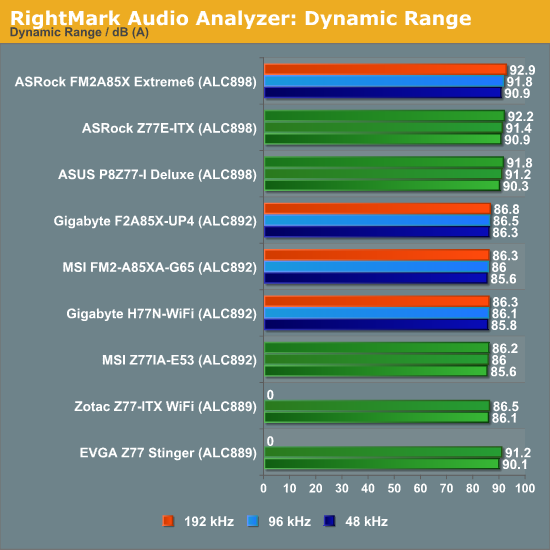
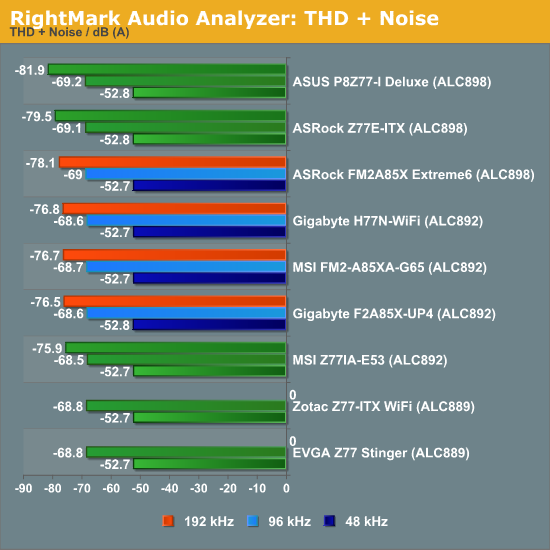
In each of our tests we can clearly see how the better codec outperforms the lower models. In this case, the ASUS and ASRock have the edge over the others.
USB 3.0 Backup
For this benchmark, we run CrystalDiskMark to determine the ideal sequential read and write speeds for the USB port using our 240 GB OCZ Vertex3 SSD with a SATA 6 Gbps to USB 3.0 converter. Then we transfer a set size of files from the SSD to the USB drive using DiskBench, which monitors the time taken to transfer. The files transferred are a 1.52 GB set of 2867 files across 320 folders – 95% of these files are small typical website files, and the rest (90% of the size) are the videos used in the WinRAR test.
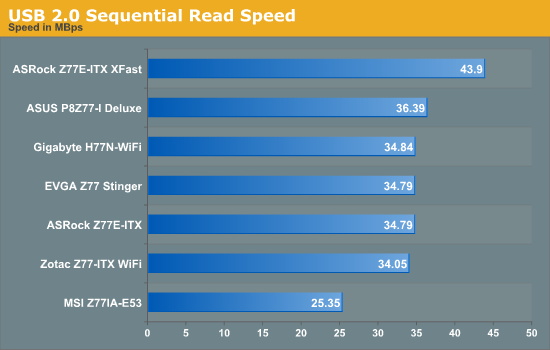
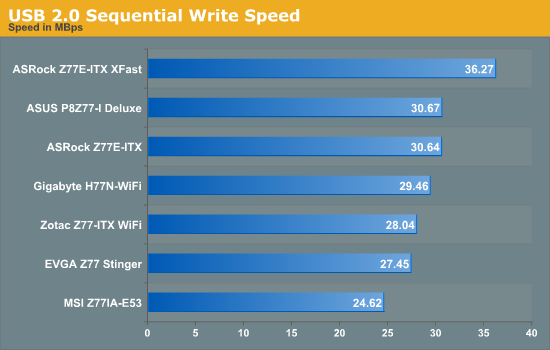
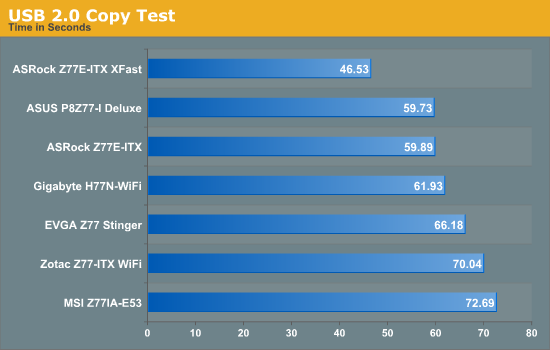
As mentioned in the bulk of the review, the MSI Z77IA-E53 struggles with USB 2.0 speed. The XFast implementation by ASRock puts it on top, however without the XFast software the ASUS gets top honors.
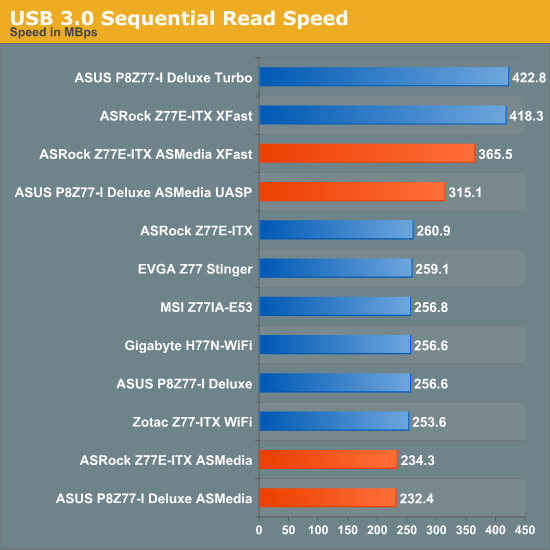
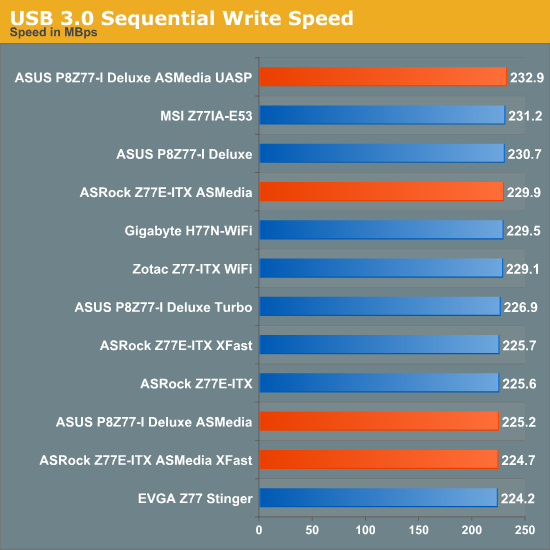
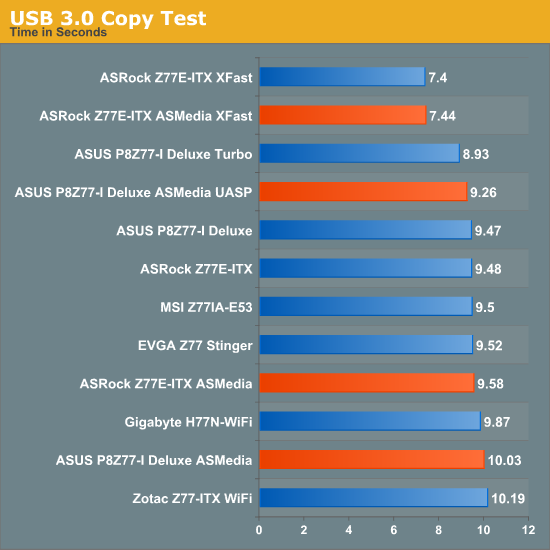
Bars in orange indicate non-chipset USB 3.0 ports coming from controllers.
For USB 3.0, both ASUS and ASRock have utilites at their disposal to increase throughput. As mentioned in previous reviews, the ASRock implementation prioritises bulk transfers, whereas the ASUS implementation significantly boosts small file transfers. Without these features, the ASUS tops the copy chart, but only just.
DPC Latency
Deferred Procedure Call latency is a way in which Windows handles interrupt servicing. In order to wait for a processor to acknowledge the request, the system will queue all interrupt requests by priority. Critical interrupts will be handled as soon as possible, whereas lesser priority requests, such as audio, will be further down the line. So if the audio device requires data, it will have to wait until the request is processed before the buffer is filled. If the device drivers of higher priority components in a system are poorly implemented, this can cause delays in request scheduling and process time, resulting in an empty audio buffer – this leads to characteristic audible pauses, pops and clicks. Having a bigger buffer and correctly implemented system drivers obviously helps in this regard. The DPC latency checker measures how much time is processing DPCs from driver invocation – the lower the value will result in better audio transfer at smaller buffer sizes. Results are measured in microseconds and taken as the peak latency while cycling through a series of short HD videos - under 500 microseconds usually gets the green light, but the lower the better.

Our magical number for DPC Latency with modern technology is 200 microseconds, which every board manages to do except the EVGA (and the EVGA does not miss by much).










54 Comments
View All Comments
mike_b - Monday, December 31, 2012 - link
Interesting article, but I have to ask why would someone spend more for a Z77 chipset when using 'just' an i3? Surely a much cheaper H61 chipset could do the job admirably, and at much lower cost.Z77 makes sense if you're overclocking, which is excluded from this test...
IanCutress - Monday, December 31, 2012 - link
H61 has no chipset USB 3.0, no chipset SATA 6 Gbps, and you are limited to PCIe 2.0. H61 is also technically limited to one single sided DIMM per channel, and no SATA RAID. There's also SRT to consider, that would be advantageous with the ASRock and the mSATA on the rear.Ian
mike_b - Monday, December 31, 2012 - link
It might make an interesting comparison to see what net advantage is gained with the added features of the Z77 chipset compared with the H61. If budgets are limited the ~100 dollar cost difference between the Z77 and H61 mainboards makes a big difference; that money saved could be put into something which makes more of a performance difference (SSD rather than HDD for example).Anandtech is one of the best tech sites around, you guys do a great job. I do sometimes see though an emphasis on more expensive products when in terms of real-world performance you could get almost the same thing at a much cheaper price. Might be worth mentioning somewhere.
Not least because with yet another new socket coming with Haswell all these 1155 boards will be seen as out of date soon anyway.
IanCutress - Monday, December 31, 2012 - link
Once we get into the swing with Haswell, we will hopefully covering the whole spectrum. Though it is worth noting that motherboard manufacturers, want to put their best foot forward, and would prefer their halo/channel boards get covered before their OEM / low end offerings. Hence this is why you rarely see many mainstream reviews that are not from forums dedicated to the market segment and users testing their own equipment. We are hoping to rectify the balance in due course. If there are any specific products you might want us to test or examine, drop me an email and I'll see what I can put in my schedule (as full as it is[!]) :)Ian
StormyParis - Monday, December 31, 2012 - link
This is a major issue, not limited to motherboards: whenever I'm looking for something middle of the road or outright cheap, I can't find reviews.These Z77 MBs are a nice example: even though I'm recommending/building PCs regularly, most of them mini-ITX, I never came across a use case for Z77. Nobody apart from teens that still have something to prove overclocks anymore. People who want to do multi-GPU get a big case, and a big board. Are we supposed the extrapolate that the makers of good Z77 boards also make good H77 and H61 boards ?
I understand you've got to make do with what you're given by the OEMs. And that reviews was very good, as usual. Pity it is irrelevant ?
Tech-Curious - Monday, December 31, 2012 - link
That's an interesting observation. I have to say, I never noticed a significant lack of coverage for low-to-mid-range components (either in general or on Anandtech in particular), until this Fall, when I was in the market for a lower end motherboard.I guess I just always gravitated to higher end mobos before. Or maybe the coverage for such products was more comprehensive years ago. My memory's foggy, so it's hard to say.
In any case, motherboards appear to be the exception. If anything, I think the internet has generally grown more bullish on low-to-mid-range CPUs and GPUs in recent years (probably, in part, as a result of the stagnating console situation, which results in stagnating system requirements for games).
But all of that rambling aside, yeah. It'd be nice to see more diverse motherboard analysis. When I bought a b75 a couple of months ago, I literally couldn't find a review for that chipset. It wasn't a big deal; it's not like b75's features are any great mystery, after all -- but it is a little nettlesome to trip over sixty bajillion z77 reviews when there's nary peep about any other chipset.
In other news, Ian's review is a good one -- and given that I've been a faithful user of Asus motherboards for the last 15 years, it's nice to see them take home the prize. :)
Etern205 - Saturday, January 5, 2013 - link
My guess would be, why review a cheap board when majority of the readers here won't even bother buying it?And as for Asus boards, I've heard, they do something called based-line features. This means all boards from the bottom of the range to the top (Intel B75-Z77) will have the same base-line features, other features are just added like BT, WiFi, extra lan, etc.
Tech-Curious - Wednesday, January 9, 2013 - link
Yes, I think the issue is that (at least with respect to Intel chipsets) low-end motherboards don't support overclocking. So they're both less interesting to review (fewer measurable differences in performance among different models), and they're less appealing to the presumed audience of sites like Anandtech.Still, the B75 is a perfectly good chipset. If you aren't heavily invested in overclocking, z77's advantages are likely wasted on you. Personally, I'm well beyond my overclocking days; I just don't have the time or the patience to go through the almost endless tuning process anymore. (Even if you find a stable OC at the outset, it can become unstable later, and/or a given application might expose instability that stress testing didn't, weeks or even months down the road).
jonjonjonj - Friday, January 4, 2013 - link
just cause you don't overclock doesn't mean other people don't. why wouldn't you? because you want to get the fastest cpu that you can afford means you have something to prove? some people are just idiots.Zap - Monday, December 31, 2012 - link
But there isn't a $100 difference between H61 and Z77. There is a cheaper Gigabyte Z77 ITX board that's only around $60 more than the cheapest H61 ITX board, and it was even on sale recently for another $13 off making it less than $50 difference.Alternately one can go the H77 ITX route and get all the Z77 goodies except for overclocking, for around $30 less than the cheapest Z77 ITX. I think $30 more than H61 is reasonable for those extra features, plus guaranteed out-of-the-box BIOS support for Ivy Bridge.
I do agree with your (mike_b) first post regarding the choice of CPU used. Ian Cutress, didn't you have a spare K CPU laying around? There are so many people building overclocked ITX rigs these days. I did in a Silverstone SG05 with low profile air cooler to hit 4.2GHz. Plenty of others use the Bitfenix Prodigy and liquid cooling to hit clocks normally reserved for ATX rigs. Another review site (Tweaktown) tested overclocking on Z77 ITX boards and the ASRock hit near 4.8GHz. THAT'S what I want to see.
Of course this AnandTech roundup has some very useful information too, such as DPC latency tests and POST times. Keep up the good work there! But please, know your audience. Next time if the board is supposed to be overclockable, test that feature.
Maybe there can be a companion article about overclocking and heatsink clearance? Would be a shame to not overclock this nice collection of Z77 ITX boards.